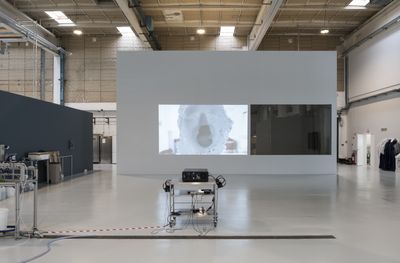Rasmus RøhlingPablo the Asshole (2015)Video17:35’HD Video
Kasia,
Remember when we talked about arrogance, and you said that the virtues of arrogance could be achieved and exercised without actually being arrogant?
I can’t remember how we went from there to the topic of Moyra Davey, but I think I tried (polemically) to make the point that Moyra enacted virtuosity in a way similar to what you talked about regarding arrogance, somehow utilizing its capacity without producing its effect.
I’m at a point in my research where I’m basically comparing Moyra’s way of (anti)inhabiting the artist’s role, to how, in the first Alien movie, Sigourney Weaver as Ripley inhabits the (up till that point very male-dominated) role of the Space- Joe/protagonist. Ripley is a manifestation of Freudian male trauma (male fear of penetration, misunderstanding of pregnancy, blah blah) subverted into this domesticized maternal figure/architecture/plot. (Critic Barbara Creed even talks about the movie as a series of shape-shifting representations of what she refers to as “The monstrous-feminine as archaic mother”…!)
In Moyra’s Fifty Minutes, when she is in the bedroom, entangled in the family: interrupted by the husband, by the son, the dog walks into the shot. To me, this is the iconic scene in Alien: Ripley, casual in her cotton panties in the belly of the spaceship entangled in wires and armature. Unceremoniously working the mechanism, running the ship, but resisting the bad trip of “Captianness”, the formal bullshit of the uniform. On this ship Moyra/Ripley runs business from her bedroom cockpit, resisting that the interpolative mechanisms of the genre run her, so to speak.
This “in-bed” casualness, as strategy, is the evolution of the artistic process at its climax: right before the sad point where it is churned into the artwork. Serra right before he turns into steel (really bad comparison, but you know what I mean).
I keep thinking of “the artwork” as the representation of absence: absence of the artist, and the role of the artist as one who always works towards replacing her/himself with a virtuoso-type gesture which is to make a sublime account for the artist’s intentions and (lost) presence.
Moyra resists this virtuoso ritual; she subverts the virtuoso maneuver and is (in the etymological origin of virtuoso as connoting manliness) exactly anti-manliness. Moyra resists the execution of virtuoso representation. Rather, Moyra is presence: she is an infrastructure of simultaneous affection and investigation. Symbiotically both surrounded by and surrounding her subject matter, now finding deep, intimate, diaristic confidentiality in it, yet nesting it, contextualizing it. She makes no effort though to export this into the artistic gesture => to accumulate these functions in order to turn them into /towards a virtuous (potent) gesture.
Moyra keeps it domestic, never sends anything off, never sets anything forth, rather we appear to “find her” in her (seemingly) civilian state in the domestic midst of her own chronology.
Fifty Minutes, just as one example, is (formally) a piece just like any other piece, yet it exist and achieves its function/meaning/status, without submitting to the virtuoso means. All this is terribly problematic, especially comparing Moyra Davey to a maternal monstrosity, and I really have no interest in employing this kind of gendered rhetorics, but until I get it calibrated, it is really meant as a very big compliment as she has modeled an exact alternative to the conventions around virtuosity, which I still think is hugely influential/problematic to artistic processing.
xR
Biography
Rasmus Røhling (born 1982) is a Danish artist.
